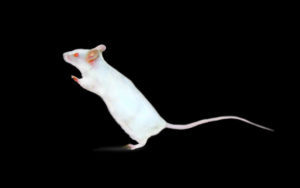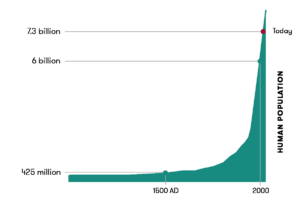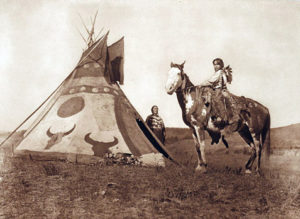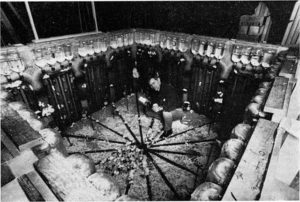
I first heard of Dr. John B. Calhoun’s work while an undergrad at Indiana State University. During a Sociology 170 class, our instructor made passing reference to the behavioral research Calhoun had done with rodents. The implications of his research in regards to human society intrigued me from the outset. Now, living in a 21st Century world that seems crippled by societal dysfunction, I wonder more than ever if Calhoun’s work with rodents was prophetic. Let me explain.
Over the course of time from the late 1940’s to the early 1970’s, Dr. Calhoun carried out a series of experiments by which he hoped to understand the effects of high population density on the social behavior of rats and mice.
carried out a series of experiments by which he hoped to understand the effects of high population density on the social behavior of rats and mice.
First, I should point out that we owe a vote of thanks to the acquiescent lab mice and rats of the world1. They have been used for over a century as experimental animals. Because their physiology is quite similar to ours (over 90% of our genomes are shared), these animals have given us great insight into the mechanisms and treatments of human diseases in areas such as immunology, pharmacology, toxicology, and genetics.
The lab rodent’s ability to remember, learn, and socially interact has been used to study and give us a better understanding of the principles of learning and social behavior. Such knowledge can, in turn, provide insight into human behavior. And this brings us back to the social behavior experiments of Dr. Calhoun (1917-1995).
One of Calhoun’s final, most illuminating experiments was designed thusly. First an enclosure, called Universe 25 by Calhoun, was constructed for the mice. This experimental arena measured about 8ft. X 8ft. and contained hundreds of living compartments and burrows. Food and water were supplied in unlimited quantities. Into this compound, a veritable Eden for mice, Calhoun introduced four pairs of animals.
During the first three months of the experiment the mice behaved normally. They mated, nested, marked territories, and interacted as mice normally do. At the end of this time, Universe 25 had a population of just over 600 mice. But all was not well; soon after this the mouse Eden began its descent into mouse Hell.
The decline began with somewhat subtle changes. Calhoun designed the enclosure to be spacious and capable of housing a few thousand mice. In spite of this, they began crowding into particular areas where food was shared while ignoring other, unoccupied food stations. Calhoun characterized this odd behavior as a . . . phenomenon in which the learned need for proximity to others . . . at a resource site gained dominance over the primary need, in this case food (my underline).
Soon a schism developed among male mice. They began to separate themselves into high and low status cohorts. Low status males were rebuffed by females, stopped even trying to mate, and withdrew to themselves to eat and sleep. The higher status males eventually became more aggressive. Suddenly, without apparent reason, they would violently attack other members of the colony. These aggressive, higher ranking males sexually assaulted other mice without regard to their gender. The females soon began to behave abnormally as well. They too became aggressive and their parental skills atrophied. Young were attacked, abandoned, or even cannibalized. Infant mortality rates approached 100%.
As Universe 25 approached its 18th month, reproduction within the colony began to decline. Calhoun marked this event as the beginning of the “death phase” whereby the once Utopian population began its slide into an irreversible extinction. Because of the pathological behavior of their parents, mice which were born just before the onset of the “death phase” received no training in normal social behavior. They spent all their time grooming themselves while lazily accepting the unlimited food and water provided. They lived unmated, apart from other mice and made no contributions whatsoever to the social functioning of the colony. In recognition of their fine coats Calhoun called these mice the “beautiful ones”.
Although the population of Universe 25 eventually reached over 2000 mice, the social fabric of the colony had long since broken down. The last mating occurred after two and one half years of colony existence. After months of stressful events including individuals going violently berserk, others totally withdrawing from society, youngsters succumbing to cannibalism, or having mothers who had lost their nesting and maternal instincts not one mouse survived.
Calhoun called this societal breaking point (manifested by a wide variety of abnormal behaviors) the behavioral sink. This so-called “sink” he defined as the point past which the slide into total societal breakdown and subsequent extinction was irretrievable. He had found that the natural social and survival behaviors of the rodents were severely altered by the stresses associated with living in a high-population-density environment.
At this point, I am compelled to admit that I have no expertise in ethology, the science of animal behavior. Nor should I be accredited talent in psychology. It should also be noted that many arguments have been made against equating the behavior of Calhoun’s mice with human behavior. It is certainly an interesting topic to explore. But wow! I can’t help but see parallels between the pathological social behavior of Calhoun’s rodents and the myriad of social dysfunctions we see in today’s human societies. Is there evidence that this is so?
Perhaps we should first ask whether or not earth’s human population density has increased much over time? It has been estimated that the planet’s human population in 1000 A.D was around 310,000,000. About 47% of earth’s land surface (24,642,757 sq. mi.) is habitable; this is the area that excludes deserts, mountains, etc. (zo.utexas.edu/courses/Thoc/land.html). These figures give us a population density of 12.5 people/sq. mi. at that time. The human population of earth is now around 7,600,000,000. The result is an average population density of 308 people/sq. mi. of habitable land. This is a 2,464% increase in human population density on habitable land over a period of ten centuries. So yes, human population density has increased dramatically over time.
density has increased much over time? It has been estimated that the planet’s human population in 1000 A.D was around 310,000,000. About 47% of earth’s land surface (24,642,757 sq. mi.) is habitable; this is the area that excludes deserts, mountains, etc. (zo.utexas.edu/courses/Thoc/land.html). These figures give us a population density of 12.5 people/sq. mi. at that time. The human population of earth is now around 7,600,000,000. The result is an average population density of 308 people/sq. mi. of habitable land. This is a 2,464% increase in human population density on habitable land over a period of ten centuries. So yes, human population density has increased dramatically over time.
ABC news has reported that between Saturday, July 17 and Friday, July 23, 2021 the Gun Violence Archive tracked at least 1,018 shooting incidents in the U.S. This is a shooting every 10 minutes. Sudden, violent outbursts of aggression (88% by men) left at least 404 people dead and 928 wounded. I can’t help but reflect back to the alpha males in Calhoun’s study which suddenly ran violently amok and attacked their own colony members.
Action.org reported that in January 2018, 552,830 people were counted as homeless in the United States. Over one-third of these people were either mentally ill or suffered from substance abuse. Granted, this is only around 6% of the total U.S. population but it does represent an exceedingly large group of people who have withdrawn and are basically absent from the normal social functioning of our country. In Japan, a whole class of men some half-million strong (the so-called hikikomori)2 are recognized as social loners and involuntary celibates. In the U.S. large numbers of males are similarly socially isolated. Referred to as NEETS (Not in Education, Employment, or Training), a Pew Research Center study suggest that there may be as many as ten million such men in the U.S. An article in New York magazine suggests that such men, account for somewhere between 23 and 46 percent of the decrease in young men’s participation in the labor force. Sound eerily similar to the totally disconnected “beautiful ones” in Calhoun’s mouse colony?
What about sexual dysfunction? The website medicalnewstoday.com identifies and defines some 16 gender identities among humans. These include agender, androgyne, bigender, butch, cisgender, gender expansive, gender fluid, gender outlaw, polygender, and transgender. Of course genetics does influence gender identification. In light of this, perhaps any of the above identities could be considered biologically genuine. But in comparison to the sexual identities we have recognized for centuries (male- gay – female) a question must be asked. Are all the above identities normal points on the sexuality spectrum? Are they individualities we simply hadn’t yet discovered? Or, are they evidence of anomalous sexual behaviors driven to expression by the societal pressures of excessive population density? Could it actually be that the recent explosion in human gender identities parallels the descent of Calhoun’s mice into hypersexual, pansexual, and asexual social pathologies?
The National Children’s Alliance reports that annually nearly 700,000 children are abused in the U.S. each year. Well over half of these cases (61%) involved simple neglect. Annually about 1800 children die from abuse or neglect. Remember the female mice in Calhoun’s study which abandoned, ignored, or even killed their own young? Is this similarity in pathologies (rodent-human) coincidental? I am left to wonder.
There could be more examples given. I haven’t even considered the destructive, ongoing wars between the religious sects and ethnic groups of the world. Political tribalism within our own country, and others, is flourishing and unproductive. The environmental havoc we have wreaked on our planetary home is directly related to the exponential growth of the human population3. The recently released United Nations Intergovernmental Report on Climate Change is frightening beyond belief. That is, if one has confidence in the predictive power of science and has even an iota of concern about our own “Universe 25” – the one we will leave to our descendants. Might these negative social interactions be taken as evidence of population-induced societal stress among humans? Isn’t it a given that increasing numbers of people require more resources and must crowd into the finite amount of habitable land we have?
As those of you who have followed by blogs recall, my underlying thesis has been the value to humans of exposure to nature4. Many, many studies have shown the positive effects of contact with the natural world on our physical and psychological health. Thus, those of us fortunate enough to live in rural settings are able to avoid many of the stressors found in densely populated, urban environments. In fact research (Li & Kanazawa, 2016) indicates that people in rural areas tend to be happier overall than those in urban zones. But even in rural settings the negative effects of population density are not absent.
Recently more insidious threats to the well-being of rural and urban folk alike have reared their ugly heads. These are the 24 hour news cycle and the growth of social media. Modern technology allows constant exposure to news even in the most remote corners of the world. Today an unceasing cascade of the world’s calamities can be delivered to everyone’s front door. If we do not exercise caution, we can find ourselves relentlessly bombarded with pictures of violent crime, humanitarian disasters, and global social unrest. Not the sorts of things that help to calm us or reassure us that we live in a world of order and safety.
The population density of rural Sullivan County, Indiana may be 46/sq. mi. but thanks to our computer or cell phone it might as well be 16,122/sq. mi. (Tokyo). Any post, comment, or photo can become instant fodder for anyone in the world to analyze, argue over, or reply to with venomous hatred. Such bickering and cyber-bullying strike me as psychological versions of the stressful physical attacks Calhoun’s densely populated mice constantly endured.
In addition the abundance of misinformation, disinformation, and conspiracy theories to be found in the cyber world are tremendously destructive. They cause vulnerable individuals to disconnect from the very nature of the reality in which they live. The risks of psychological stress and unhealthy social interaction provoked by too much time “online” are quite real. They do nothing more than ensure that we will not be able to interact in a beneficial, cooperative way; a necessity if human society is to function effectively.
Can we avoid our own fall into the behavioral sink? The challenges are  many. Research suggests that our human ancestors lived in social groups of around 150 people; as do several hunter-gatherer societies currently (Dunbar, 1992). Dunbar further proposed that when group size exceeds this number, the group becomes unstable and begins to fragment. Dunbar believes that the size of the human neocortex limits the brain’s information processing capacity and this limits the number of relationships an individual can monitor simultaneously. Therefore functional group size is limited to around 150 among primates. Could this mean that the progression toward our own behavioral sink is inevitable simply because we have far exceeded the ideal human global population size (and social structure) thus creating social complexities that our minds are incapable of efficiently processing?
many. Research suggests that our human ancestors lived in social groups of around 150 people; as do several hunter-gatherer societies currently (Dunbar, 1992). Dunbar further proposed that when group size exceeds this number, the group becomes unstable and begins to fragment. Dunbar believes that the size of the human neocortex limits the brain’s information processing capacity and this limits the number of relationships an individual can monitor simultaneously. Therefore functional group size is limited to around 150 among primates. Could this mean that the progression toward our own behavioral sink is inevitable simply because we have far exceeded the ideal human global population size (and social structure) thus creating social complexities that our minds are incapable of efficiently processing?
One branch of psychology suggests that we perceive and respond to the current environment as if it were the ancestral environment in which our social behavioral responses evolved (Toby & Cosmides, 1990). Cultural evolution proceeds much more rapidly than biological evolution. Therefore, could it be that we irrationally respond to increased population density pressures because social instincts, first developed during our less-populated primordial history, can no longer cope? Might not such research help explain the human social dysfunctions I have summarized previously?
Maybe the incredible ability of humans to find technological answers to problems will save us from our current turmoil. Surely we must reclaim our ability to recognize threats to global society and our capacity to work cooperatively to solve them. Are we capable? Or are we humans, much like the ill-fated residents of Universe 25, at a tipping point – our own behavioral sink? Time will tell. I hope against hope that we are capable of rising to the challenge.
 In the meantime, let us recall that less than 500 generations ago all human ancestors were hunter-gatherers whose survival depended upon a deep connection to, an understanding of, and a reverence for the natural world. This relationship is instinctively deep-rooted within us yet. A simple walk in a forest still enthralls us and enhances our mood. How many still enjoy the solitude, scenery, and rewards of our favorite fishing spot, spring mushroom woods, city park, or camping spot? The huge crowds which nowadays surge into our state and national parks offer proof that we still yearn for our ancestral connection to nature. Think about how we are drawn as if magnetically to the ocean surf. Consider our inclination to stand in wonderment as we gaze upon magnificent vistas such as the Tetons, Yosemite Valley, the Grand Canyon, or the Milky Way as it fills the pitch-black, night sky. Yes, in the interim, there are ways to lighten the stresses put upon us by modern human society. There are ways to regain our sanity. They lie just outside our door.
In the meantime, let us recall that less than 500 generations ago all human ancestors were hunter-gatherers whose survival depended upon a deep connection to, an understanding of, and a reverence for the natural world. This relationship is instinctively deep-rooted within us yet. A simple walk in a forest still enthralls us and enhances our mood. How many still enjoy the solitude, scenery, and rewards of our favorite fishing spot, spring mushroom woods, city park, or camping spot? The huge crowds which nowadays surge into our state and national parks offer proof that we still yearn for our ancestral connection to nature. Think about how we are drawn as if magnetically to the ocean surf. Consider our inclination to stand in wonderment as we gaze upon magnificent vistas such as the Tetons, Yosemite Valley, the Grand Canyon, or the Milky Way as it fills the pitch-black, night sky. Yes, in the interim, there are ways to lighten the stresses put upon us by modern human society. There are ways to regain our sanity. They lie just outside our door. 
Photo Credits: White mouse photo by Pogrebnoj-Alexandroff @ commons.wikimedia.org John B. Calhoun @ en.wikipedia.org Calhoun’s mouse Utopia @ commons.wikimedia.org Robin Dunbar @ commons.wikimedia.org World population growth graph @ Australian Academy of Science Assiniboin tepee and rider by Edward S. Curtis courtesy of Lewis-Clark.org Moraine Lake. Alberta, Canada by the author. Further Reading:
-
The Mighty Mouse: The Impact of Rodents on Advances in Biomedical Research (nih.gov)
-
The World of American Hikikomori (nymag.com)
-
Animated Map: Visualizing 200 Years of U.S. Population Density (visualcapitalist.com)
-
What are the Benefits of Interacting with Nature? (nih.gov)
-
For an interesting summary of Dr. Calhoun’s work: READ-Crowding (mayfieldschools.org)

